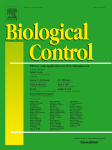View Item
- xmlui.general.dspace_homeCentros Regionales y EEAsCentro Regional Entre RíosEEA ConcordiaArtículos científicosxmlui.ArtifactBrowser.ItemViewer.trail
- DSpace Home
- Centros Regionales y EEAs
- Centro Regional Entre Ríos
- EEA Concordia
- Artículos científicos
- View Item
Life history traits of the coccinellids Scymnus subvillosus and S. interruptus on their prey Aphis spiraecola and A. gossypii: Implications for biological control of aphids in clementine citrus
Abstract
Predator-prey interactions are not static, but spatially and temporally dynamic. In addition to the climatic conditions and the prey density, the dynamics of predator populations may be influenced by the suitability of their diet. Therefore, to better understand aphid predator-prey relationships within food webs, it is necessary to know how their life history traits are affected by diet quality. In this research, under laboratory conditions, the
[ver mas...]
Predator-prey interactions are not static, but spatially and temporally dynamic. In addition to the climatic conditions and the prey density, the dynamics of predator populations may be influenced by the suitability of their diet. Therefore, to better understand aphid predator-prey relationships within food webs, it is necessary to know how their life history traits are affected by diet quality. In this research, under laboratory conditions, the suitability of the two most abundant aphid species in citrus agroecosystems of the Western Mediterranean basin, Aphis gossypii and A. spiraecola were evaluated for two of their principle natural enemies, the coccinellid predators Scymnus subvillosus and S. interruptus. The intrinsic rate of increase of S. subvillosus was found to be higher than that of S. interruptus regardless of the type of prey consumed. Some biological parameters of S. interruptus were lower when they were exclusively fed A. spiraecola; as opposed to when only fed A. gossypii. These differences were not found with S. subvillosus. When a mixed diet of both aphids was offered, the fitness of both predators was higher than when they were each fed only a single aphid species. These laboratory observations were further confirmed under field conditions, wherein S. subvillosus abundance was greater in those colonies where A. spiraecola was predominant. On the other hand both, S. subvillosus and S. interruptus were found equally in A. gossypii colonies. Implications of these results for the biological control of aphids in this crop are discussed.
[Cerrar]

Author
Bouvet, Juan Pedro;
Urbaneja, Alberto;
Monzó, César;
Fuente
Biological Control 132 : 49-56 (May 2019)
Date
2019-05
Editorial
Elsevier
ISSN
1049-9644
1090-2112
1090-2112
Formato
pdf
Tipo de documento
artículo
Palabras Claves
Derechos de acceso
Restringido
 Excepto donde se diga explicitamente, este item se publica bajo la siguiente descripción: Creative Commons Attribution-NonCommercial-ShareAlike 2.5 Unported (CC BY-NC-SA 2.5)
Excepto donde se diga explicitamente, este item se publica bajo la siguiente descripción: Creative Commons Attribution-NonCommercial-ShareAlike 2.5 Unported (CC BY-NC-SA 2.5)

